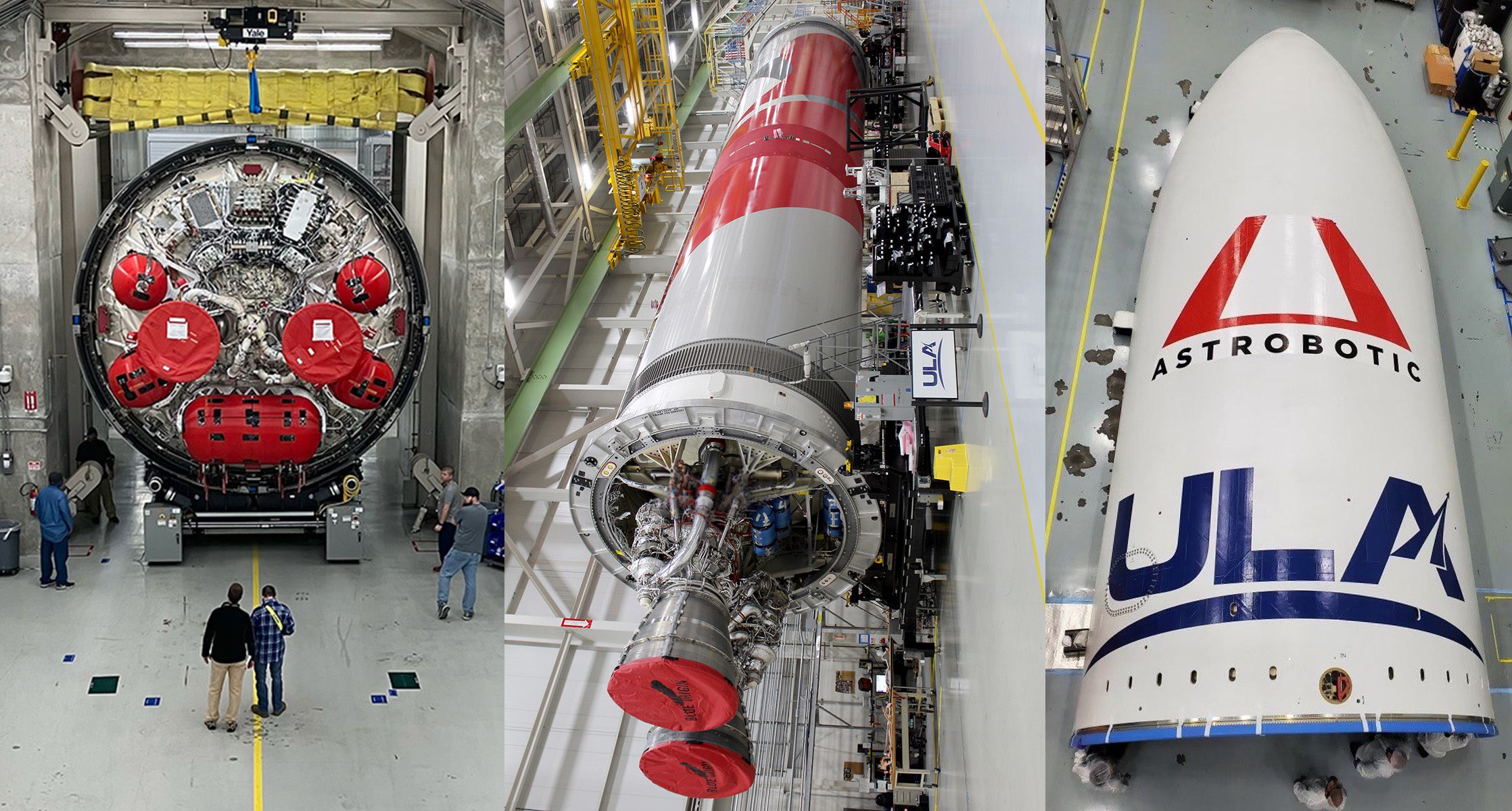
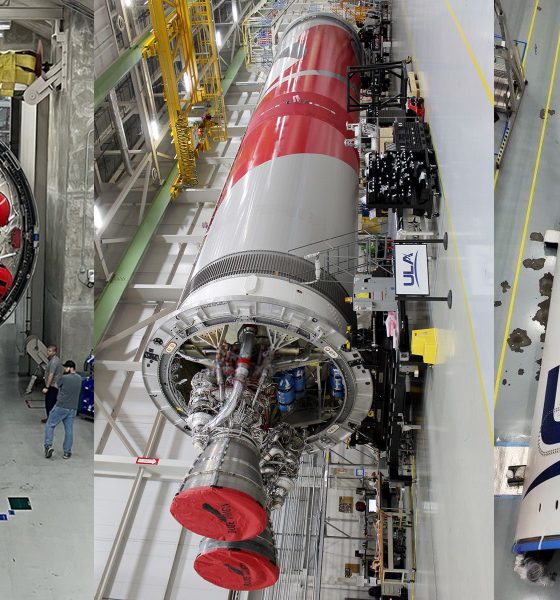
News
ULA set to ship Vulcan rocket to Florida for Moon lander launch
After many years of delays, all the parts of the United Launch Alliance’s next-generation Vulcan Centaur rocket are about to converge on Florida for their first launch.
Unveiled in 2015, ULA has been working on Vulcan Centaur since at least 2014. Following Russia’s first illegal invasion of Ukraine, countries around the world attempted to punish the aggressor mainly through economic sanctions. In the US, those sanctions included bans on the import of most Russian aerospace technologies, including the RD-180 engines that still power ULA’s Atlas V workhorse rocket in 2023. In 2014, ULA announced that it would work with Blue Origin to integrate the startup’s BE-4 engine into a new rocket booster to end its reliance on Russian engines.
More than eight years later, that BE-4 engine is finally ready for flight, and the rest of the first two-stage Vulcan rocket appears to be right behind it.
The update that's rolling out to the fleet makes full use of the front and rear steering travel to minimize turning circle. In this case a reduction of 1.6 feet just over the air— Wes (@wmorrill3) April 16, 2024
Eastward-bound
In a burst of New Year activity, CEO Tory Bruno confirmed that Vulcan Flight 1’s core stage (booster) has been fully assembled, buttoned up, and loaded onto ULA’s transport ship. The aptly named RocketShip will ferry the booster from ULA’s Decatur, Alabama factory to Cape Canaveral, Florida, where it will enter the final stages of launch preparation at the company’s Cape Canaveral Space Force Station (CCSFS) LC-41 pad.
Simultaneously, ULA has finished proof testing Vulcan’s first Centaur V upper stage, a larger and more advanced version of the Centaur III stage ULA and its predecessors have been flying for decades. Centaur V is almost twice as wide as Centaur III and is designed to hold two and a half times more propellant, enabling significantly higher performance in some scenarios.
Additionally, while ULA has partially abandoned plans for a reusable upper stage called ACES (Advanced Cryogenic Evolved Stage), some of those improvements may still be added to Centaur V. Compared to Centaur III, Centaur V’s longevity in space will grow from 8 to 12 hours. ULA is also developing a “mission extension kit” that will allow it to operate for multiple months – unprecedented for a rocket stage powered by cryogenic propellant.
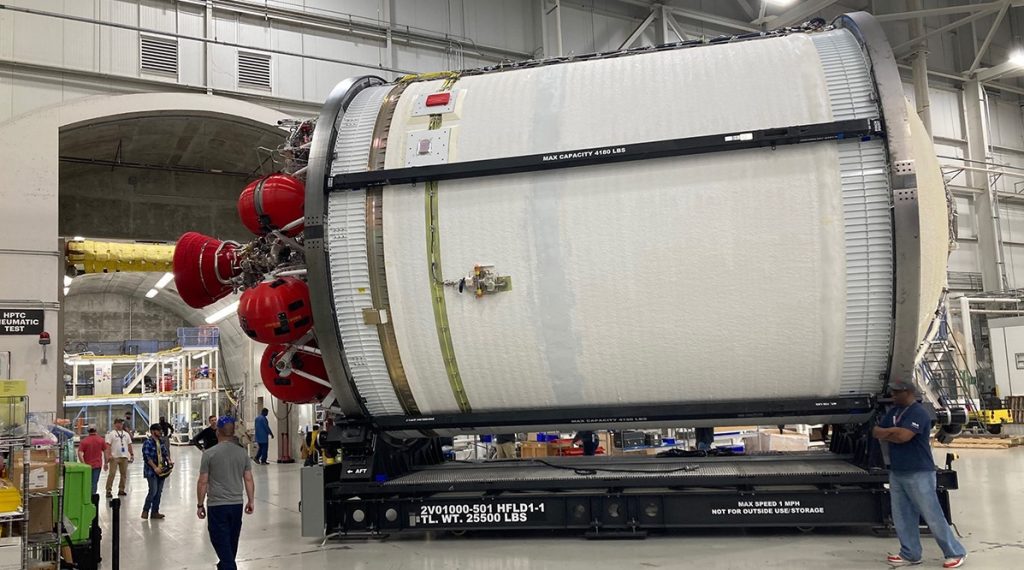
Photos taken by a local paper appear to indicate that ULA is shipping one or more payload fairing (nosecone) halves alongside Vulcan’s first flightworthy booster. While unconfirmed, it would make sense for ULA to ship Vulcan’s booster and fairing together. Another tweet from Tory Bruno indicates that ULA intends to ship Vulcan’s booster and upper stage together, increasing the odds that all components will be aboard RocketShip when it departs for Florida.
A New Workhorse
Vulcan Centaur is ultimately designed to fully replace ULA’s existing Delta IV and Atlas V rockets. Building and operating two very different rockets simultaneously is undoubtedly one of the reasons that ULA’s launch costs are so much higher than SpaceX’s, and simplifying to a single production line is one clear way to achieve major cost savings. ULA hopes that the simplest version of Vulcan will eventually cost about $100 million per launch – still far more than SpaceX’s base Falcon 9 price [PDF] but potentially more competitive than Atlas V. That’s unclear, though, as Bruno has previously stated that Atlas V’s launch costs have fallen to about $100 million apiece thanks to unrelated cost savings.
Regardless, Vulcan Centaur will be a capable rocket and its price is close enough to SpaceX’s extremely competitive Falcon 9 for it to be a mostly valid option for launch customers who want diversity or want to avoid SpaceX for less rational reasons. Vulcan has secured more than 70 launch contracts thanks to ULA’s intimate relationship with the US military and Amazon’s reluctance to launch its Project Kuiper internet satellites with the company behind Starlink, a direct competitor.
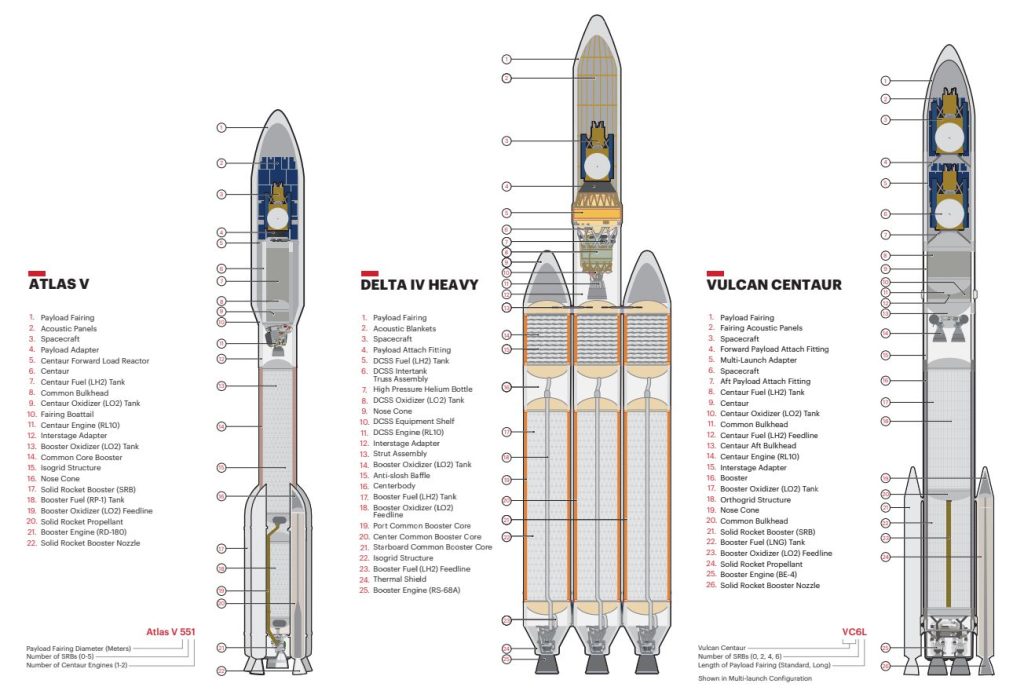
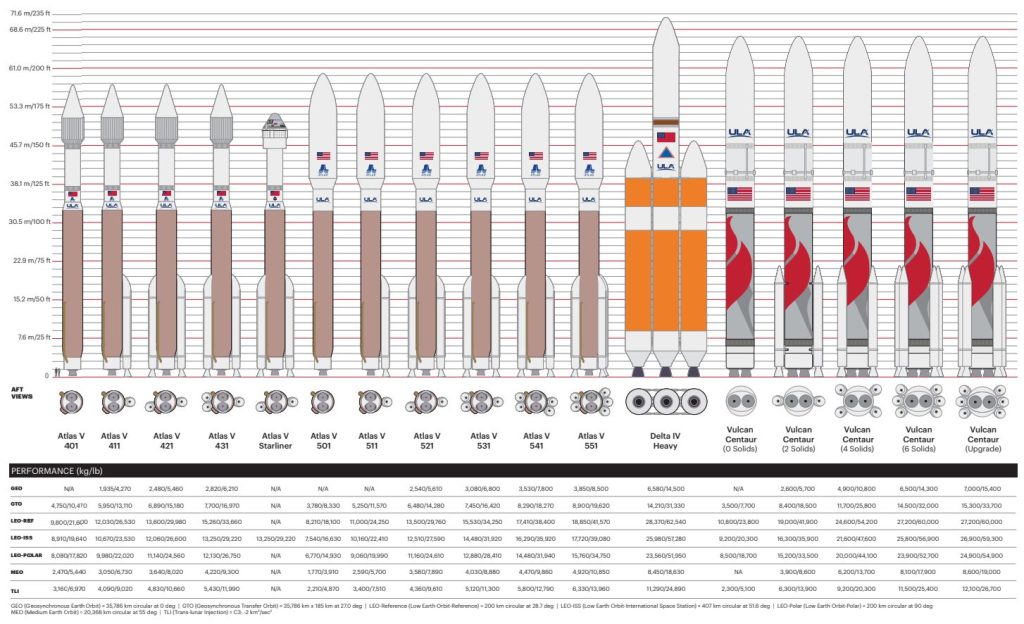
Fitted with two BE-4 engines, six solid rocket boosters (SRBs), and unknown upgrades, ULA says the most capable version of Vulcan Centaur will be able to launch up to 12.1 tons (26,700 lb) to the Moon, 15.3 tons (33,700 lb) to geostationary transfer orbit (GTO), and 27.2 tons (60,000 lb) to low Earth orbit (LEO). To high orbits, the most capable Vulcan variant will fairly competitive with SpaceX’s Falcon Heavy rocket. To low orbits, it will generally match or slightly exceed the performance of an expendable Falcon 9, but likely for a much higher price. By every measure, the simplest and cheapest Vulcan variant is significantly less capable than even a partially reusable Falcon 9 and will likely cost 50-100% more.
Moon or bust
Indicating ULA’s confidence in the unflown rocket, the main target of Vulcan’s first launch is the Moon. Vulcan Flight 1 will carry two main payloads: the first two Amazon Kuiper satellite prototypes and Pittsburgh startup Astrobotic’s first Peregrine Moon lander. After deploying both Kuiper satellites in low Earth orbit, Centaur V will fire up again and attempt to send the 1.3-ton (~2850 lb) Peregrine lander directly to the Moon – also known as a trans-lunar injection (TLI) burn. Developed as part of NASA’s Commercial Lunar Payload Services (CLPS) program, Peregrine will be tasked with entering orbit around the Moon and eventually landing up to 70-90 kilograms (150-200 lb) of payload on the lunar surface.
The first Peregrine Moon lander is fully assembled and currently in the middle of extensive integrated testing. If successful, ULA CEO Tory Bruno says that Vulcan will likely be ready to launch sometime in Q1 2023, though Q2 2023 is more likely.

Elon Musk
Tesla AI Head says future FSD feature has already partially shipped

Tesla’s Head of AI, Ashok Elluswamy, says that something that was expected with version 14.3 of the company’s Full Self-Driving platform has already partially shipped with the current build of version 14.2.
Tesla and CEO Elon Musk have teased on several occasions that reasoning will be a big piece of future Full Self-Driving builds, helping bring forth the “sentient” narrative that the company has pushed for these more advanced FSD versions.
Back in October on the Q3 Earnings Call, Musk said:
“With reasoning, it’s literally going to think about which parking spot to pick. It’ll drop you off at the entrance of the store, then go find a parking spot. It’s going to spot empty spots much better than a human. It’s going to use reasoning to solve things.”
Musk said in the same month:
“By v14.3, your car will feel like it is sentient.”
Amazingly, Tesla Full Self-Driving v14.2.2.2, which is the most recent iteration released, is very close to this sentient feeling. However, there are more things that need to be improved, and logic appears to be in the future plans to help with decision-making in general, alongside other refinements and features.
On Thursday evening, Elluswamy revealed that some of the reasoning features have already been rolled out, confirming that it has been added to navigation route changes during construction, as well as with parking options.
He added that “more and more reasoning will ship in Q1.”
🚨 Tesla’s Ashok Elluswamy reveals Nav decisions when encountering construction and parking options contain “some elements of reasoning”
More uses of reasoning will be shipped later this quarter, a big tidbit of info as we wait v14.3 https://t.co/jty8llgsKM
— TESLARATI (@Teslarati) January 9, 2026
Interestingly, parking improvements were hinted at being added in the initial rollout of v14.2 several months ago. These had not rolled out to vehicles quite yet, as they were listed under the future improvements portion of the release notes, but it appears things have already started to make their way to cars in a limited fashion.
Tesla Full Self-Driving v14.2 – Full Review, the Good and the Bad
As reasoning is more involved in more of the Full Self-Driving suite, it is likely we will see cars make better decisions in terms of routing and navigation, which is a big complaint of many owners (including me).
Additionally, the operation as a whole should be smoother and more comfortable to owners, which is hard to believe considering how good it is already. Nevertheless, there are absolutely improvements that need to be made before Tesla can introduce completely unsupervised FSD.
Elon Musk
Tesla’s Elon Musk: 10 billion miles needed for safe Unsupervised FSD
As per the CEO, roughly 10 billion miles of training data are required due to reality’s “super long tail of complexity.”

Tesla CEO Elon Musk has provided an updated estimate for the training data needed to achieve truly safe unsupervised Full Self-Driving (FSD).
As per the CEO, roughly 10 billion miles of training data are required due to reality’s “super long tail of complexity.”
10 billion miles of training data
Musk comment came as a reply to Apple and Rivian alum Paul Beisel, who posted an analysis on X about the gap between tech demonstrations and real-world products. In his post, Beisel highlighted Tesla’s data-driven lead in autonomy, and he also argued that it would not be easy for rivals to become a legitimate competitor to FSD quickly.
“The notion that someone can ‘catch up’ to this problem primarily through simulation and limited on-road exposure strikes me as deeply naive. This is not a demo problem. It is a scale, data, and iteration problem— and Tesla is already far, far down that road while others are just getting started,” Beisel wrote.
Musk responded to Beisel’s post, stating that “Roughly 10 billion miles of training data is needed to achieve safe unsupervised self-driving. Reality has a super long tail of complexity.” This is quite interesting considering that in his Master Plan Part Deux, Elon Musk estimated that worldwide regulatory approval for autonomous driving would require around 6 billion miles.
FSD’s total training miles
As 2025 came to a close, Tesla community members observed that FSD was already nearing 7 billion miles driven, with over 2.5 billion miles being from inner city roads. The 7-billion-mile mark was passed just a few days later. This suggests that Tesla is likely the company today with the most training data for its autonomous driving program.
The difficulties of achieving autonomy were referenced by Elon Musk recently, when he commented on Nvidia’s Alpamayo program. As per Musk, “they will find that it’s easy to get to 99% and then super hard to solve the long tail of the distribution.” These sentiments were echoed by Tesla VP for AI software Ashok Elluswamy, who also noted on X that “the long tail is sooo long, that most people can’t grasp it.”
News
Tesla earns top honors at MotorTrend’s SDV Innovator Awards
MotorTrend’s SDV Awards were presented during CES 2026 in Las Vegas.

Tesla emerged as one of the most recognized automakers at MotorTrend’s 2026 Software-Defined Vehicle (SDV) Innovator Awards.
As could be seen in a press release from the publication, two key Tesla employees were honored for their work on AI, autonomy, and vehicle software. MotorTrend’s SDV Awards were presented during CES 2026 in Las Vegas.
Tesla leaders and engineers recognized
The fourth annual SDV Innovator Awards celebrate pioneers and experts who are pushing the automotive industry deeper into software-driven development. Among the most notable honorees for this year was Ashok Elluswamy, Tesla’s Vice President of AI Software, who received a Pioneer Award for his role in advancing artificial intelligence and autonomy across the company’s vehicle lineup.
Tesla also secured recognition in the Expert category, with Lawson Fulton, a staff Autopilot machine learning engineer, honored for his contributions to Tesla’s driver-assistance and autonomous systems.
Tesla’s software-first strategy
While automakers like General Motors, Ford, and Rivian also received recognition, Tesla’s multiple awards stood out given the company’s outsized role in popularizing software-defined vehicles over the past decade. From frequent OTA updates to its data-driven approach to autonomy, Tesla has consistently treated vehicles as evolving software platforms rather than static products.
This has made Tesla’s vehicles very unique in their respective sectors, as they are arguably the only cars that objectively get better over time. This is especially true for vehicles that are loaded with the company’s Full Self-Driving system, which are getting progressively more intelligent and autonomous over time. The majority of Tesla’s updates to its vehicles are free as well, which is very much appreciated by customers worldwide.








